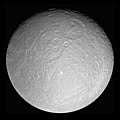File:PIA07763 Rhea full globe5.jpg
Appearance

Hammi agarsiisa yaalii: pikseelii 600 × 600. Kabiraa furmaatawwan: pikseelii 240 × 240 | pikseelii 480 × 480 | pikseelii 768 × 768 | pikseelii 1,024 × 1,024 | pikseelii 2,048 × 2,048 | pikseelii 4,920 × 4,920.
Faayila abbaa (4,920 × 4,920 pixels, file size: 2.67 MB, MIME type: image/jpeg)
Seenaa faayilaa
Faayilicha sa'aa san akka itti mul'atetti ilaaluuf guyyaa/yeroo cuqaasi.
| Guyyaa/Sa'aa | Qeensa abgudduu | Kallattiiwwan | Fayyadamaa | Yaada | |
|---|---|---|---|---|---|
| amma | 07:15, 27 Haggaya 2018 |  | 4,920 × 4,920 (2.67 MB) | PlanetUser | Reverted to version as of 08:13, 13 March 2015 (UTC) |
| 10:09, 15 Haggaya 2018 |  | 4,920 × 4,920 (2.66 MB) | The NMI User | Reverted to version as of 23:49, 14 August 2018 (UTC) | |
| 23:59, 14 Haggaya 2018 |  | 4,920 × 4,920 (2.64 MB) | The NMI User | rv, fixed | |
| 23:49, 14 Haggaya 2018 |  | 4,920 × 4,920 (2.66 MB) | The NMI User | Try making black | |
| 23:44, 14 Haggaya 2018 |  | 4,920 × 4,920 (2.65 MB) | The NMI User | Fixed | |
| 08:09, 13 Haggaya 2018 |  | 4,920 × 4,920 (3.67 MB) | The NMI User | Removing black borders | |
| 08:01, 13 Haggaya 2018 |  | 4,920 × 4,920 (2.67 MB) | The NMI User | Reverted to version as of 08:13, 13 March 2015 (UTC) | |
| 07:56, 13 Haggaya 2018 |  | 4,920 × 4,920 (5.67 MB) | The NMI User | Black background | |
| 08:13, 13 Bitootessa 2015 |  | 4,920 × 4,920 (2.67 MB) | MoreTomorrow | making square (to match other planet/moon images) | |
| 06:43, 30 Onkoloolessa 2008 |  | 4,920 × 4,820 (2.68 MB) | WolfmanSF | This is the same full-resolution NASA image, with black panels added to the margins and some Photoshop processing to enhance contrast. |
Fayyadamiinsa faayilaa
Kutaan itti anuu "file"ii kanan walitti qabatta:
Fayyadamiinsa faayila guutu addunyaa
Wikileen biroo kan armaan gadi jiran fayila kana fayyadamu:
- Fayyadamiinsa af.wikipedia.org irratti
- Fayyadamiinsa an.wikipedia.org irratti
- Fayyadamiinsa ar.wikipedia.org irratti
- ريا
- ريا (قمر)
- جيوفاني دومينيكو كاسيني
- قالب:المجموعة الشمسية
- قائمة أجرام المجموعة الشمسية مرتبة حسب الحجم
- قائمة الأجرام المستديرة بالجاذبية في المجموعة الشمسية
- قائمة الأقمار الطبيعية
- خط زمني لاكتشاف كواكب المجموعة الشمسية وأقمارها
- اكتشاف واستكشاف النظام الشمسي
- قائمة أنواع الكواكب
- مهمة نظام تيتان زحل
- قائمة أكبر الفوهات في المجموعة الشمسية
- 1981 ميداس
- حلقات ريا
- قالب:ريا (قمر)
- Fayyadamiinsa ary.wikipedia.org irratti
- Fayyadamiinsa arz.wikipedia.org irratti
- Fayyadamiinsa ast.wikipedia.org irratti
- Fayyadamiinsa as.wikipedia.org irratti
- Fayyadamiinsa azb.wikipedia.org irratti
- Fayyadamiinsa be.wikipedia.org irratti
- Fayyadamiinsa bh.wikipedia.org irratti
- Fayyadamiinsa ca.wikipedia.org irratti
- Fayyadamiinsa ckb.wikipedia.org irratti
- Fayyadamiinsa cy.wikipedia.org irratti
- Fayyadamiinsa de.wikipedia.org irratti
- Fayyadamiinsa el.wikipedia.org irratti
- Fayyadamiinsa en.wikipedia.org irratti
Mul'isa fayyadama duniyaalessa edaasaa harshama kanaa.



